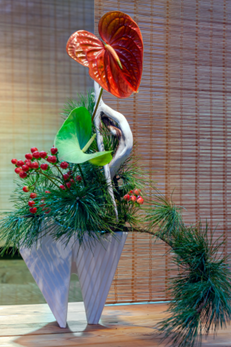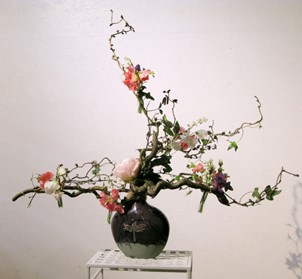Understanding the art of Japanese Ikebana
The art of Ikebana, an age-old Japanese tradition, transcends simple floral composition to become a profound form of artistic expression. With Bouvard Fleurs, expert in flower bouquet delivery, discover in this article this art that can enrich your floral experience and bring a touch of serenity to your environment.

Ikebana: more than just flower arranging
Ikebana, which means "bringing flowers to life", is a traditional Japanese art of flower arrangement. It is an aesthetic art, but above all a spiritual journey, similar to other Japanese practices such as Chadô or the way of tea. Ikebana is taught to women as soon as they enter school, as an essential skill for potential marriage, along with calligraphy and the art of the tea ceremony.
Basic principles of Ikebana
Ikebana uses flowers, but also branches, buds and various other plants, selected for their seasonality, colour and texture. The flowers and small branches are carefully arranged in a variety of containers, including bowls, vases, wickerwork and various other types of vessel. Even in its purest form, an Ikebana obeys the three main lines representing the trinity, symbolising harmony between heaven, man and earth, a fundamental triad in Buddhist philosophy.
Teaching Ikebana
Ikebana has mainly been taught and passed down orally from generation to generation, leaving little written documentation on its principles. However, concepts such as Zen and wabi-sabi provide keys to understanding this art, which is deeply rooted in Zen Buddhism and its vision of the world. Although many schools of Ikebana exist today, they all share a common basic structure in their traditional compositions.

Evolution of Ikebana
This Japanese floral art is constantly evolving, and each school of ikebana develops its own style. This evolution leads to the emergence of various styles. It reflects Ikebana's adaptability to contemporary trends and its ability to incorporate new influences. However, the fundamentals of the art remain universally constant.
Today, Ikebana is appreciated the world over for its aesthetic appeal and its ability to bring peace and meditation into the living space. It blends perfectly with modern decors, adding a touch of nature and serenity to the hustle and bustle of everyday life.
The Symbolism Behind the Arrangements
Each element of an Ikebana arrangement has a deep symbolic meaning. Branches often represent elements of nature such as mountains, water and the sky, while flowers express ephemeral life. Leaves and dead branches can also be incorporated to represent the natural cycle of life. In this way, each arrangement becomes a meditation on nature and the human condition.

Ikebana in the Modern World
Although deeply rooted in tradition, Ikebana continues to thrive in the modern world. Ikebana exhibitions are held across Japan and around the world, allowing artists to share their creative interpretations of this ancient art. More and more people, both inside and outside Japan, are taking up Ikebana as a way of finding inner peace and strengthening their connection with nature.
SEASONAL BOUQUETS
FAQ about Ikebana
How do I get started with Ikebana ?
To begin practising Ikebana, it's essential to first familiarise yourself with its fundamental principles. Choose a style that inspires and speaks to you. Then carefully select flowers and branches that are suitable for your arrangements. Make sure they are fresh and of high quality, to get the best results from your floral arrangements.
What types of flowers are most commonly used in Ikebana ?
The flowers used in Ikebana vary according to the season. Flowers such as chrysanthemums, irises and cherry branches are frequently used. The important thing is to choose flowers that reflect the season and the natural aesthetic.
Can I learn Ikebana on my own ?
Yes, self-study of Ikebana is possible thanks to an abundance of books and resources available online. These materials provide a solid basis for understanding the principles and techniques of this floral art. However, taking part in a workshop or course has one notable advantage: direct interaction with an experienced instructor. What's more, group classes can stimulate your creativity and inspire you through the creations of other participants.


